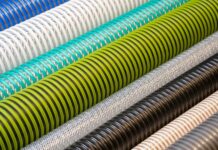
“Omniphobic” might sound like a way to describe someone who is afraid of everything, but it actually refers to a special type of surface that repels virtually any liquid. Such surfaces could potentially be used in everything from ship hulls that reduce drag and increase efficiency, to coverings that resist stains and protect against damaging chemicals. But the omniphobic surfaces developed so far suffer from a major problem: Condensation can quickly disable their liquid-shedding properties.
Now, researchers at MIT have found a way to overcome this effect, producing a surface design that drastically reduces the effects of condensation, although at a slight sacrifice in performance. The new findings are described in the journal ACS Nano, in a paper by graduate student Kyle Wilke, professor of mechanical engineering and department head Evelyn Wang, and two others.
Creating a surface that can shed virtually all liquids requires a precise kind of texture that creates an array of microscopic air pockets separated by pillars or ridges. These air pockets keep most of the liquid away from direct contact with the surface, preventing it from “wetting,” or spreading out to cover a whole surface. Instead, the liquid beads up into droplets.
“Many liquids are perfectly wetting, meaning the liquid completely spreads out,” says Wilke. These include many of the refrigerants used in air conditioners and refrigerators, hydrocarbons such as those used as fuels and lubricants, and many alcohols. “Those are very difficult to repel. The only way to do it is through very specific surface geometry, which is not that easy to make,” he adds.
Various groups are working on fabrication methods, he says, but with surface features measured in tens of microns (millionths of a meter) or less, “it can make it quite hard to fabricate, and can make the surfaces quite fragile.”
If such surfaces are damaged — for example, if one of the tiny pillars is bent or broken — it can defeat the whole process. “One local defect can destroy the entire surface’s ability to repel liquids,” he says. And condensation, such as dew forming because of a temperature difference between the air and the surface, acts in the same way, destroying the omniphobicity.
“We considered: How can we lose some of the repellency but make the surface robust” against both damage and dew, Wilke says. “We wanted a structure that one defect wouldn’t destroy.” After much calculation and experimentation, they found a geometry that meets that goal thanks, in part, to microscopic air pockets that are disconnected rather than connected on the surfaces, making spreading between pockets much less likely.
The features have to be very small, he explains, because when droplets form they are initially at the scale of nanometers, or billionths of a meter, and the spacing between these growing droplets can be less than a micrometer.
Read more: A new approach to liquid-repelling surfaces
thumbnail courtesy of phys.org
Related Links:
Flexible electronics breakthrough could lead to a revolution
Wearable sensors mimic skin to help with wound healing process
Team increases adhesiveness of silicone using the example of geckos














